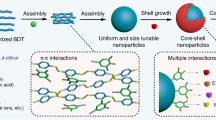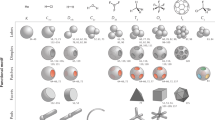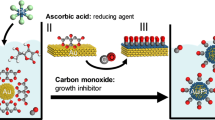Abstract
Colloidal hybrid nanoparticles contain multiple nanoscale domains fused together by solid-state interfaces. They represent an emerging class of multifunctional lab-on-a-particle architectures that underpin future advances in solar energy conversion, fuel-cell catalysis, medical imaging and therapy, and electronics. The complexity of these ‘artificial molecules’ is limited ultimately by the lack of a mechanism-driven design framework. Here, we show that known chemical reactions can be applied in a predictable and stepwise manner to build complex hybrid nanoparticle architectures that include M–Pt–Fe3O4 (M = Au, Ag, Ni, Pd) heterotrimers, MxS–Au–Pt–Fe3O4 (M = Pb, Cu) heterotetramers and higher-order oligomers based on the heterotrimeric Au–Pt–Fe3O4 building block. This synthetic framework conceptually mimics the total-synthesis approach used by chemists to construct complex organic molecules. The reaction toolkit applies solid-state nanoparticle analogues of chemoselective reactions, regiospecificity, coupling reactions and molecular substituent effects to the construction of exceptionally complex hybrid nanoparticle oligomers.
This is a preview of subscription content, access via your institution
Access options
Subscribe to this journal
Receive 12 print issues and online access
$259.00 per year
only $21.58 per issue
Buy this article
- Purchase on Springer Link
- Instant access to full article PDF
Prices may be subject to local taxes which are calculated during checkout





Similar content being viewed by others
References
Costi, R., Saunders, A. E. & Banin, U. Colloidal hybrid nanostructures: a new type of functional materials. Angew. Chem. Int. Ed. 49, 4878–4897 (2010).
Wang, C., Xu, C., Zeng, H. & Sun, S. Recent progress in synthesis and applications of dumbbell-like nanoparticles. Adv. Mater. 21, 3045–3052 (2009).
Cozzoli, P. D., Pellegrino, T. & Manna, L. Synthesis, properties and perspectives of hybrid nanocrystal structures. Chem. Soc. Rev. 35, 1195–1208 (2006).
Costi, R., Saunders, A. E., Elmalem, E., Salant, A. & Banin, U. Visible light-induced charge retention and photocatalysis with hybrid CdSe–Au nanodumbbells. Nano Lett. 8, 637–641 (2008).
Elmalem, E., Saunders, A. E., Costi, R., Salant, A. & Banin, U. Growth of photocatalytic CdSe–Pt nanorods and nanonets. Adv. Mater. 20, 4312–4317 (2008).
Xu, C., Wang, B. & Sun, S. Dumbbell-like Au–Fe3O4 nanoparticles for target-specific platin delivery. J. Am. Chem. Soc. 131, 4216–4217 (2009).
Yin, H., Wang, C., Zhu, H., Overbury, S. H. & Sun, S. Colloidal deposition synthesis of supported gold nanocatalysts based on Au–Fe3O4 dumbbell nanoparticles. Chem. Commun. 4357–4359 (2008).
Wang, C., Daimon, H. & Sun, S. Dumbbell-like Pt–Fe3O4 nanoparticles and their enhanced catalysis for oxygen reduction reaction. Nano Lett. 9, 1493–1496 (2009).
Xu, C. et al. Au–Fe3O4 dumbbell nanoparticles as dual-functional probes. Angew. Chem. Int. Ed. 47, 173–176 (2008).
Choi, J-S. et al. Biocompatible heterostructured nanoparticles for multimodal biological detection. J. Am. Chem. Soc. 128, 15982–15983 (2006).
Mokari, T., Rothenberg, E., Popov, I., Costi, R. & Banin, U. Selective growth of metal tips onto semiconductor quantum rods and tetrapods. Science 304, 1787–1790 (2004).
Figuerola, A. et al. One-pot synthesis and characterization of size-controlled bimagnetic FePt–iron oxide heterodimer nanocrystals. J. Am. Chem. Soc. 130, 1477–1487 (2008).
Kwon, K-W. & Shim, M. γ-Fe2O3/II–IV sulfide nanocrystal heterojunctions. J. Am. Chem. Soc. 127, 10269–10275 (2005).
Shi, W. et al. A general approach to binary and ternary hybrid nanocrystals. Nano Lett. 6, 875–881 (2006).
Casavola, M., Buonsanti, R., Caputo, G. & Cozzoli, P. D. Colloidal strategies for preparing oxide-based hybrid nanocrystals. Eur. J. Inorg. Chem. 6, 837–854 (2008).
Nicolau, K. C., Vourloumis, D., Winssinger, N. & Baran, P. S. The art and science of total synthesis at the dawn of the twenty-first century. Angew. Chem. Int. Ed. 39, 44–122 (2000).
Choi, C. & Alivisatos, A. P. From artificial atoms to nanocrystal molecules: preparation and properties of more complex nanostructures. Annu. Rev. Phys. Chem. 61, 369–389 (2010).
Yu, H. et al. Dumbbell-like bifunctional Au–Fe3O4 nanoparticles. Nano Lett. 5, 379–382 (2005).
Wang, C., Daimon, H., Onodera, T., Koda, T. & Sun, S. A general approach to size- and shape-controlled synthesis of platinum nanoparticles and their catalytic reduction of oxygen. Angew. Chem. Int. Ed. 47, 3588–3591 (2008).
Wang, C., Yin, H., Dai, S. & Sun, S. A general approach to noble metal–metal oxide dumbbell nanoparticles and their catalytic application for CO oxidation. Chem. Mater. 22, 3277–3282 (2010).
Gu, H., Yang, Z., Gao, J., Chang, C. K. & Xu, B. Heterodimers of nanoparticles: formation at a liquid–liquid interface and particle-specific surface modification by functional molecules. J. Am. Chem. Soc. 127, 34–35 (2005).
Xu, Z., Hou, Y. & Sun, S. Magnetic core/shell Fe3O4/Au and Fe3O4/Au/Ag nanoparticles with tunable plasmonic properties. J. Am. Chem. Soc. 129, 8698–8699 (2007).
Zhang, H-T., Ding, J., Chow, G-M. & Dong, Z-L. Engineering inorganic hybrid nanoparticles: tuning combination fashions of gold, platinum, and iron oxide. Langmuir 24, 13197–13202 (2008).
Mazumder, V. & Sun, S. Oleylamine-mediated synthesis of Pd nanoparticles for catalytic formic acid oxidation. J. Am. Chem. Soc. 131, 4588–4589 (2009).
Zhang, L., Dou, Y-H. & Gu, H-C. Synthesis of Ag–Fe3O4 heterodimeric nanoparticles. J. Colloid Interface Sci. 297, 660–664 (2006).
Choi, S-H. et al. Simple and generalized synthesis of oxide–metal heterostructured nanoparticles and their applications in multimodal biomedical probes. J. Am. Chem. Soc. 130, 15573–15580 (2008).
Jang, Y. et al. Simple synthesis of Pd–Fe3O4 heterodimer nanocrystals and their application as a magnetically recyclable catalyst for Suzuki cross-coupling reactions. Phys. Chem. Chem. Phys. 13, 2512–2516 (2011).
Casavola, M. et al. Topologically controlled growth of magnetic metal-functionalized semiconductor oxide nanorods. Nano Lett. 7, 1386–1395 (2007).
Casavola, M. et al. Exchange-coupled bimagnetic cobalt/iron oxide branched nanocrystal heterostuctures. Nano Lett. 9, 366–376 (2009).
Wang, C. et al. Rational synthesis of heterostructured nanoparticles with morphology control. J. Am. Chem. Soc. 132, 6524–6529 (2010).
Lide, D. R. CRC Handbook of Chemistry and Physics 87th edn (CRC Press, 2006).
Smith, N. Photoemission spectra and band structures of d-band metals. III. Model band calculations on Rh, Pd, Ag, Ir, Pt, and Au. Phys. Rev. B 9, 1365–1376 (1974).
Tauster, S. J., Fung, S. C., Baker, R. T. K. & Horsley, J. A. Strong interactions in supported-metal catalysts. Science 211, 1121–1125 (1981).
Tauster, S. J. Strong metal–support interactions. Acc. Chem. Res. 20, 389–394 (1987).
Goodman, D. W. ‘Catalytically active Au on titania’: yet another example of a strong metal support interaction (SMSI)? Catal. Lett. 99, 1–4 (2005).
Horsley, J. A. A molecular orbital study of strong metal–support interaction between platinum and titanium dioxide. J. Am. Chem. Soc. 101, 2870–2874 (1979).
Ohyama, J., Yamamoto, A., Teramura, K., Shishido, T. & Tanaka, T. Modification of metal nanoparticles with TiO2 and metal–support interaction in photodeposition. ACS Catal. 1, 187–192 (2011).
Qin, Z-H., Lewandowski, M., Sun, Y-N., Shaikhutdinov, S. & Freund, H-J. Encapsulation of Pt nanoparticles as a result of strong metal–support interaction with Fe3O4 (111). J. Phys. Chem. C 112, 10209–10213 (2008).
Barr, T. L. Modern ESCA: The Principles and Practice of X-Ray Photoelectron Spectroscopy (CRC Press, 1994).
Weiss, W. & Ranke, W. Surface chemistry and catalysis on well-defined epitaxial iron-oxide layers. Prog. Surf. Sci. 70, 1–151 (2002).
Lim, W. P., Wong, C. T., Ang, S. L., Low, H. Y. & Chin, W. S. Phase-selective synthesis of copper sulfide nanocrystals. Chem. Mater. 18, 6170–6177 (2006).
Regulacio, M. D. et al. One-pot synthesis of Cu1.94S–CdS and Cu1.94S–ZnxCd1–xS nanodisk heterostructures. J. Am. Chem. Soc. 133, 2052–2055 (2011).
Rahlfs, P. The cubic high-temperature modificators of sulfides, selenides, and tellurides of silver and univalent copper. Z. Phys. Chem. B 31, 157–194 (1936).
Rodriguez, J. A. et al. Coverage effects and the nature of the metal–sulfur bond in S/Au(111): high-resolution photoemission and density-functional studies. J. Am. Chem. Soc. 125, 276–285 (2003).
Carbone, L. & Cozzoli, P. D. Colloidal heterostructured nanocrystals: synthesis and growth mechanisms. Nano Today 5, 449–493 (2010).
Son, D. H., Hughes, S. M., Yin, Y. & Alivisatos, A. P. Cation exchange reactions in ionic nanocrystals. Science 306, 1009–1012 (2004).
Yin, Y. et al. Formation of hollow nanocrystals through the nanoscale Kirkendall effect. Science 304, 711–714 (2004).
Vasquez, Y., Henkes, A. E., Bauer, J. C. & Schaak, R. E. Nanocrystal conversion chemistry: a unified and materials-general strategy for the template-based synthesis of nanocrystalline solids. J. Solid State Chem. 181, 1509–1523 (2008).
Beveridge, J. S. et al. Purification and magnetic interrogation of hybrid Au–Fe3O4 and FePt–Fe3O4 nanoparticles. Angew. Chem. Int. Ed. 50, 9875–9879 (2011).
Latham, A. H., Frietas, R. S., Schiffer, P. & Williams, M. E. Capillary magnetic field flow fractionation and analysis of magnetic nanoparticles. Anal. Chem. 77, 5055–5062 (2005).
Beveridge, J. S., Stephens, J. R., Latham, A. H. & Williams, M. E. Differential magnetic catch and release: analysis and separation of magnetic nanoparticles. Anal. Chem. 81, 9618–9624 (2009).
Chen, G. et al. High-purity separation of gold nanoparticle dimers and trimers. J. Am. Chem. Soc. 131, 4218–4219 (2009).
Wang, Y. et al. A systems approach towards the stoichiometry-controlled hetero-assembly of nanoparticles. Nat. Commun. 1:87 http://dx.doi.org/10.1038/ncomms1089 (2010).
Leonard, B. M., Anderson, M. E., Oyler, K. D., Phan, T-H. & Schaak, R. E. Orthogonal reactivity of metal and multimetal nanostructures for selective, stepwise, and spatially-controlled solid-state modification. ACS Nano 3, 940–948 (2009).
Kovalenko, M. et al. Fatty acid salts as stabilizers in size- and shape-controlled nanocrystal synthesis: the case of inverse spinel iron oxide. J. Am. Chem. Soc. 129, 6352–6353 (2007).
Choi, S-H. et al. Simple and generalized synthesis of semiconducting metal sulfide nanocrystals. Adv. Funct. Mater. 19, 1645–1649 (2009).
Acknowledgements
This work was supported primarily by the US National Science Foundation (NSF) (CHE-0845258), but with additional partial support to M.R.B. by the Penn State Materials Research Science and Engineering Center (DMR-0820404). Electron microscopy was performed at the Electron Microscopy Facility at the Huck Institutes of the Life Sciences and at the Materials Characterization Facility of the Penn State Materials Research Institute. The authors thank J. Kulik for assistance with collecting the STEM data. The authors also thank V. Bojan for acquisition and interpretation of XPS data and H. Gong for ICP-AES measurements.
Author information
Authors and Affiliations
Contributions
M.R.B. carried out all of the synthetic work and characterization by XRD, TEM and UV-vis. J.F.B. carried out and analysed the HRTEM, STEM, SAED and EDS element-mapping work. R.E.S. conceived and directed the project. M.R.B. and R.E.S. prepared the manuscript.
Corresponding author
Ethics declarations
Competing interests
The authors declare no competing financial interests.
Supplementary information
Supplementary information
Supplementary information (PDF 1084 kb)
Rights and permissions
About this article
Cite this article
Buck, M., Bondi, J. & Schaak, R. A total-synthesis framework for the construction of high-order colloidal hybrid nanoparticles. Nature Chem 4, 37–44 (2012). https://doi.org/10.1038/nchem.1195
Received:
Accepted:
Published:
Issue Date:
DOI: https://doi.org/10.1038/nchem.1195
This article is cited by
-
Modular divergent creation of dual-cocatalysts integrated semiconducting sulfide nanotriads for enhanced photocatalytic hydrogen evolution
Nano Research (2023)
-
Laser-generated high entropy metallic glass nanoparticles as bifunctional electrocatalysts
Nano Research (2022)
-
Double-helical assembly of heterodimeric nanoclusters into supercrystals
Nature (2021)
-
Surface lattice engineering for fine-tuned spatial configuration of nanocrystals
Nature Communications (2021)
-
Heterodimers of metal nanoparticles: synthesis, properties, and biological applications
Microchimica Acta (2021)



